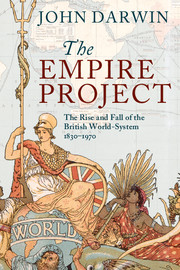Book contents
- Frontmatter
- Contents
- List of maps
- Preface and acknowledgments
- Introduction: the project of an Empire
- Part I Towards ‘The Sceptre of the World’: the elements of Empire in the long nineteenth century
- 1 Victorian origins
- 2 The octopus power
- 3 The commercial republic
- 4 The Britannic experiment
- 5 ‘Un-British rule’ in ‘Anglo-India’
- 6 The weakest link: Britain in South Africa
- 7 The Edwardian transition
- Part II ‘The great liner is sinking’: the British world-system in the age of war
- Conclusion
- Notes
- Select bibliography
- Index
6 - The weakest link: Britain in South Africa
Published online by Cambridge University Press: 11 December 2009
- Frontmatter
- Contents
- List of maps
- Preface and acknowledgments
- Introduction: the project of an Empire
- Part I Towards ‘The Sceptre of the World’: the elements of Empire in the long nineteenth century
- 1 Victorian origins
- 2 The octopus power
- 3 The commercial republic
- 4 The Britannic experiment
- 5 ‘Un-British rule’ in ‘Anglo-India’
- 6 The weakest link: Britain in South Africa
- 7 The Edwardian transition
- Part II ‘The great liner is sinking’: the British world-system in the age of war
- Conclusion
- Notes
- Select bibliography
- Index
Summary
In South Africa, the bond of empire was weaker and the strains on it much greater than in other colonies of settlement. The European whites were predominantly non-British; the indigenous blacks more numerous and resilient. The frontier wars of conquest lasted longer, were fought with greater ferocity and spread out over a whole sub-continent. For much of the nineteenth century, South Africa was viewed in London as a hybrid region: a composite of settler and ‘native’ states. Imperial policy veered unpredictably between a ‘Canadian’ solution of settler self-government and the ‘Indian’ solution of direct control – at least over the large zones where autonomous black communities survived. Partly as a result, on the white side certainly, the ‘Imperial Factor’ was regarded with profound mistrust.
South Africa was likely to be an awkward element in the imperial system at the best of times. The sub-continent was stuck in its own version of Catch-22. As long as the struggle between whites and blacks continued there could be no hope of devolving imperial authority to a settler government on the model of Canada, the Australian colonies or (most relevantly) New Zealand. The whites were too divided; and the blacks were too strong to be contained without the help of imperial troops. But every imperial effort to promote settler unity and impose a common policy towards black peoples and rulers roused fresh white animosity against London's ‘dictation’ – especially among the Afrikaner (or Boer) majority.
- Type
- Chapter
- Information
- The Empire ProjectThe Rise and Fall of the British World-System, 1830–1970, pp. 217 - 254Publisher: Cambridge University PressPrint publication year: 2009

